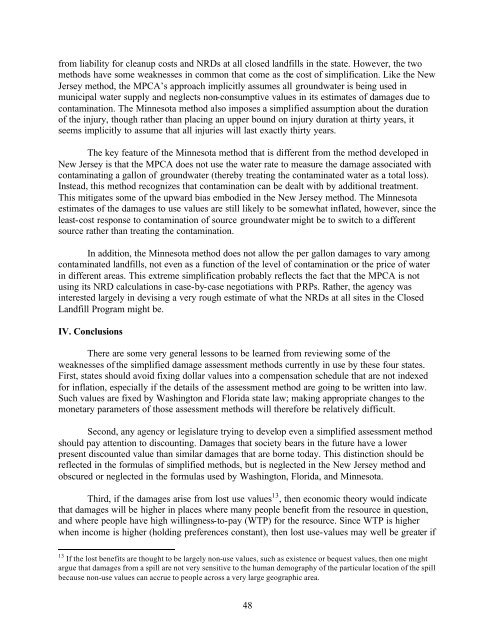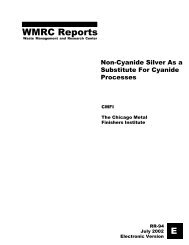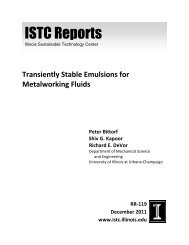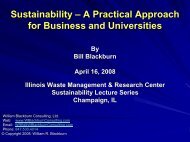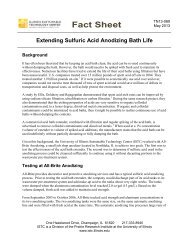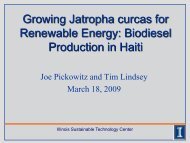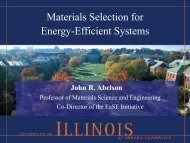Natural Resource Damage Assessment: Methods and Cases
Natural Resource Damage Assessment: Methods and Cases
Natural Resource Damage Assessment: Methods and Cases
Create successful ePaper yourself
Turn your PDF publications into a flip-book with our unique Google optimized e-Paper software.
from liability for cleanup costs <strong>and</strong> NRDs at all closed l<strong>and</strong>fills in the state. However, the two<br />
methods have some weaknesses in common that come as the cost of simplification. Like the New<br />
Jersey method, the MPCA’s approach implicitly assumes all groundwater is being used in<br />
municipal water supply <strong>and</strong> neglects non-consumptive values in its estimates of damages due to<br />
contamination. The Minnesota method also imposes a simplified assumption about the duration<br />
of the injury, though rather than placing an upper bound on injury duration at thirty years, it<br />
seems implicitly to assume that all injuries will last exactly thirty years.<br />
The key feature of the Minnesota method that is different from the method developed in<br />
New Jersey is that the MPCA does not use the water rate to measure the damage associated with<br />
contaminating a gallon of groundwater (thereby treating the contaminated water as a total loss).<br />
Instead, this method recognizes that contamination can be dealt with by additional treatment.<br />
This mitigates some of the upward bias embodied in the New Jersey method. The Minnesota<br />
estimates of the damages to use values are still likely to be somewhat inflated, however, since the<br />
least-cost response to contamination of source groundwater might be to switch to a different<br />
source rather than treating the contamination.<br />
In addition, the Minnesota method does not allow the per gallon damages to vary among<br />
contaminated l<strong>and</strong>fills, not even as a function of the level of contamination or the price of water<br />
in different areas. This extreme simplification probably reflects the fact that the MPCA is not<br />
using its NRD calculations in case-by-case negotiations with PRPs. Rather, the agency was<br />
interested largely in devising a very rough estimate of what the NRDs at all sites in the Closed<br />
L<strong>and</strong>fill Program might be.<br />
IV. Conclusions<br />
There are some very general lessons to be learned from reviewing some of the<br />
weaknesses of the simplified damage assessment methods currently in use by these four states.<br />
First, states should avoid fixing dollar values into a compensation schedule that are not indexed<br />
for inflation, especially if the details of the assessment method are going to be written into law.<br />
Such values are fixed by Washington <strong>and</strong> Florida state law; making appropriate changes to the<br />
monetary parameters of those assessment methods will therefore be relatively difficult.<br />
Second, any agency or legislature trying to develop even a simplified assessment method<br />
should pay attention to discounting. <strong>Damage</strong>s that society bears in the future have a lower<br />
present discounted value than similar damages that are borne today. This distinction should be<br />
reflected in the formulas of simplified methods, but is neglected in the New Jersey method <strong>and</strong><br />
obscured or neglected in the formulas used by Washington, Florida, <strong>and</strong> Minnesota.<br />
Third, if the damages arise from lost use values 13 , then economic theory would indicate<br />
that damages will be higher in places where many people benefit from the resource in question,<br />
<strong>and</strong> where people have high willingness-to-pay (WTP) for the resource. Since WTP is higher<br />
when income is higher (holding preferences constant), then lost use-values may well be greater if<br />
13 If the lost benefits are thought to be largely non-use values, such as existence or bequest values, then one might<br />
argue that damages from a spill are not very sensitive to the human demography of the particular location of the spill<br />
because non-use values can accrue to people across a very large geographic area.<br />
48


